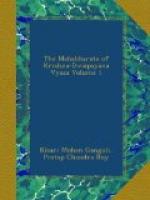in the Dwapara, still another. Diminution is
going on this age; and I have not that form now.
The ground, rivers, plants, and rocks, and siddhas,
gods, and celestial sages conform to Time, in harmony
with the state of things in the different yugas.
Therefore, do not desire to see my former shape, O
perpetuator of the Kuru race. I am conforming
to the tendency of the age. Verily, Time is irresistible’
Bhimasena said, ’Tell me of the duration of the
different yugas, and of the different manners and
customs and of virtue, pleasure and profit, and of
acts, and energy, and of life and death in the different
yugas.’ Thereupon Hanuman said, ’O
child, that yuga is called Krita when the one eternal
religion was extant. And in that best of yugas,
every one had religious perfection, and, therefore,
there was no need of religious acts. And then
virtue knew no deterioration; nor did people decrease.
It is for this that this age is called Krita (perfect).
But in time the yuga had come to be considered as an
inferior one. And, O child, in the Krita age,
there were neither gods, nor demons, nor Gandharvas,
nor Yakshas, nor Rakshasas, nor Nagas. And there
was no buying and selling. And the Sama, the
Rich, and the Yajus did not exist. And there
was no manual labour. And then the necessaries
of life were obtained only by being thought of.
And the only merit was in renouncing the world.
And during that yuga, there was neither disease, nor
decay of the senses. And there was neither malice,
nor pride, nor hypocrisy, nor discord, nor ill-will,
nor cunning, nor fear, nor misery, nor envy, nor covetousness.
And for this, that prime refuge of Yogis, even the
Supreme Brahma, was attainable to all. And Narayana
wearing a white hue was the soul of all creatures.
And in the Krita Yuga, the distinctive characteristics
of Brahmanas, Kshatriyas, Vaisyas, and Sudras were
natural and these ever stuck to their respective duties.
And then Brahma was the sole refuge, and their manners
and customs were naturally adapted to the attainment
of Brahma and the objects of their knowledge was the
sole Brahma, and all their acts also had reference
to Brahma. In this way all the orders attained
merit. And one uniform Soul was the object of
their meditation; and there was only one mantra (the
Om), and there was one ordinance. And although
of different characteristics, all of them followed
a single Veda; and they had one religion. And
according to the divisions of time, they led the four
modes of life, without aiming at any object, and so
they attained emancipation. The religion consisting
in the identification of self with Brahma indicates
the Krita Yuga. And in the Krita Yuga, the virtue
of the four orders is throughout entire in four-fold
measure. Such is the Krita Yuga devoid of the
three qualities. Do thou also hear from me of
the character of the Treta Yuga. In this age,
sacrifices are introduced, and virtue decreaseth by
a quarter. And Narayana (who is the Soul of all




